
-----
Chemical polishing defect (anodizing)
Q. The defect appears on some pieces of the rack. The finish is uneven. Some areas are matte, others have pitting... There is a clear difference within the same piece between parts with a good shine and parts with a poor shine.
The defect appears before anodizing.
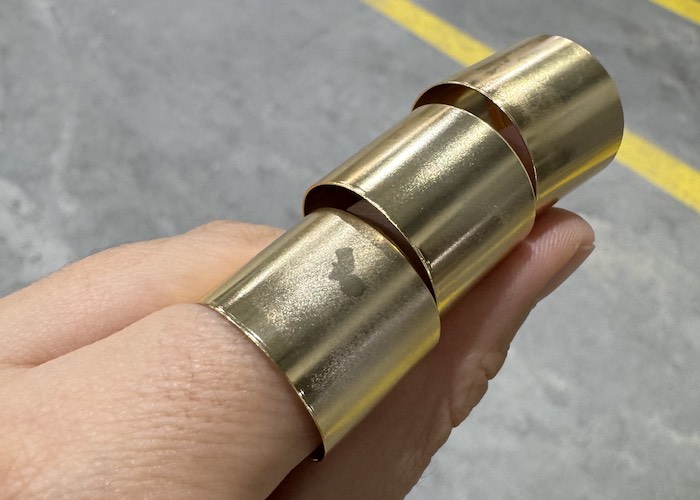
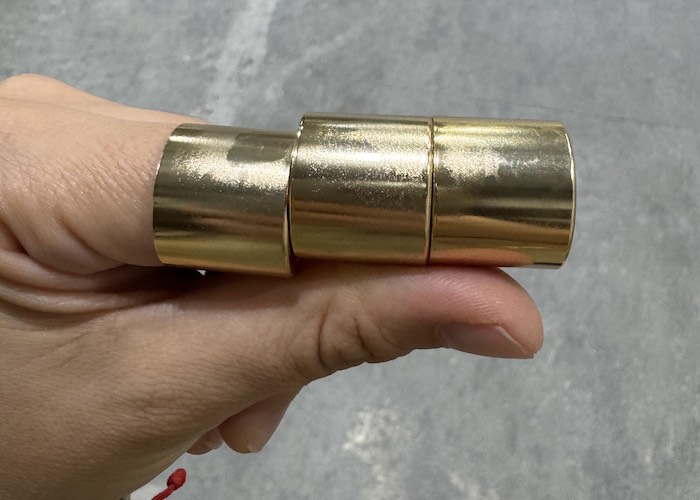
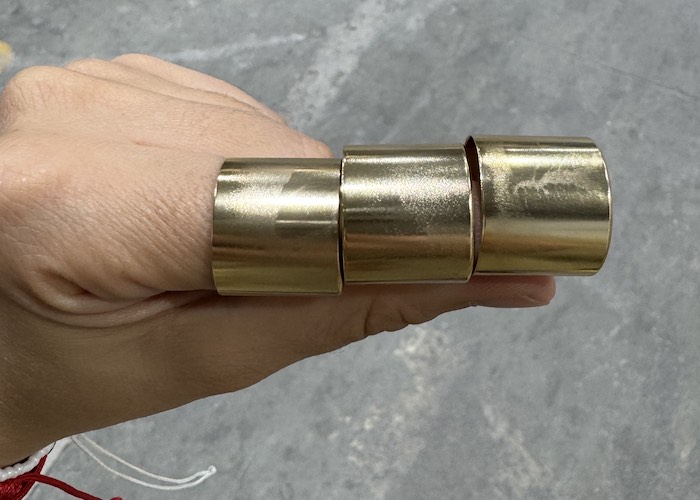
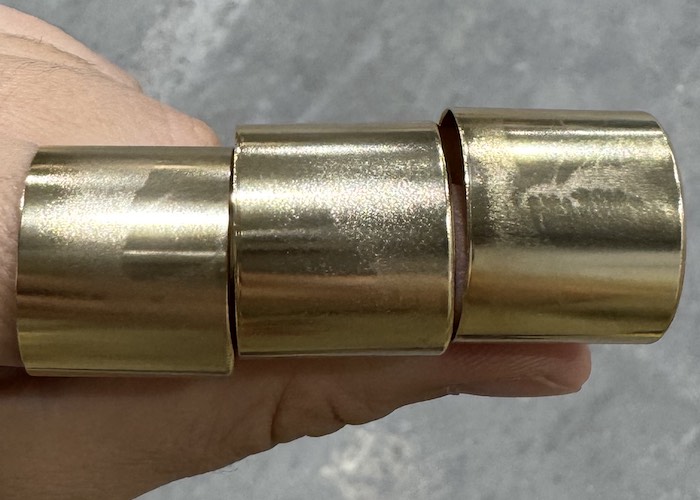
Our process is:
bright dip (H3PO4, HNO3 and H2SO4)
deox (diiron trisulphate, sulfuric acid, nitric acid)
anodizing (195 g/L, 20 °C, 17 min)
We use alloy 5657 (however other alloys are anodized, 8011, 5005)
- Spain
September 23, 2025
Greetings S
Looking at the pictures you provided, these scarred pcs bear the tell-tale signs of having an encounter with ice build-up somewhere in your bright dip tank. The frosted finish with swirls or patches that look rather dull and even pitted. This is not an uncommon occurrence for a bright dip tank. It happens to the best of us. It is possible that you may have already been alerted to this if you have noticed little chunks of ice floating in the tank on occasion, and maybe you did not realize it or if you did, you did not realize what it was, but the condition may not have gotten to that extreme yet where pieces or chunks of ice are calving from the mother chunk which has established itself at the base of your tank.
You already know that air agitation is critical to the tank, and if you have noticed the air has been reduced, you may have ice build up in the air line. If you noticed a specific area of your load that has the appearance as opposed to the entire load, that could be a clue. Also this etching appearance will usually happen on the pcs towards the bottom of the load when the tank is iced up. Ice in the air line will lend itself to the etched appearance being more wide-spread. (A good practice is to remove the air line every night after production and let it soak in a water rinse tank as this will not only aid in dissolving any ice that may be present but also keep it from building up. keep a spare line in that rinse tank and alternate their use every day. This will keep one of them in the tank long enough for the water to do its thing.) You can also rotate the airline so the holes are at the botton of the line. This will minimuze backflow when the air is turned off after your production is done.
This ice condition happens over time, and you have been sent the first signals of its presence. The good news is it is repairable but it is going to cost you some time and some chemicals. I am not a chemist not did i work in the lab at the anodizing shop, rather i was a hands on supervisor who experienced these things so I will give you the layman's explanation.
The ice is what happens when the tank chemistry goes awry. What this means specifically is your tank is thirsty for water. You may be replenishing water in the tank on a daily basis, and your chemistry may be spot on, but the facts do not lie. Rather than polishing parts as the tank is supposed to, the absence of sufficient water allows for the parts to look as though they have received a snow-bright finish( really old anodizing finish terminology) rather than brighten up. This is also known as a frost etch. The acid attacks (etches) the parts rather than polishes it.
The fix is to add more water. ( turning up the heat in the tank in an to attempt to melt the ice is not an option because it will not work. ) this type of ice will only be dissolved by adding water. You can help the matter by allowing the tank to cool and then using an ice scraper which has a long handle on it and scrape away at it. Weaken it first with water. It is a slow and cumbersome process and you may have to decommission your tank for an unspecified length of time, depending on the amount of ice that has built up over time. Also keep in mind this ice accumulates over time, but could also happen faster if you do not tend to the chemistry properly.
Just an fyi.... this problem can be encountered less frequently if you are using a 70% phosphoric as opposed to an 80% phos. The presence of 10% more water in the 70% goes a long way plus it is easier on the company pocketbook.
Another option if space is available is to pump out the tank into another tank and then you could suit up with the proper PPE and have at it. Take great care not to puncture the tank.
Take the easy way first....check the airline for ice build-up. You will see it in the holes in your air line. Ice in the air line in no way means it is not present at the bottom of your tank. It very well may be but it is a matter of to what degree or how much is present. If this is your first run in with the ice, be grateful. The tank is telling you it is a little bit sick and it is displaying its symptoms. It will only get worse, not better and you will end up processing entire loads as rejects rather than a select few if you neglect it. Good luck to you as you move forward.
Retired from 35 years in anodizing. - newport, tennessee
October 2, 2025
![]() Thank you very much for your detailed response.
Thank you very much for your detailed response.
My bright dip tank has both air and propeller agitation. On other occasions, I have experienced water shortage in my chemical polishing bath, which generated the barnacling defect (see attached photo), as well as partial crystallization of the bath that produced chip-like flakes (see attached photo).
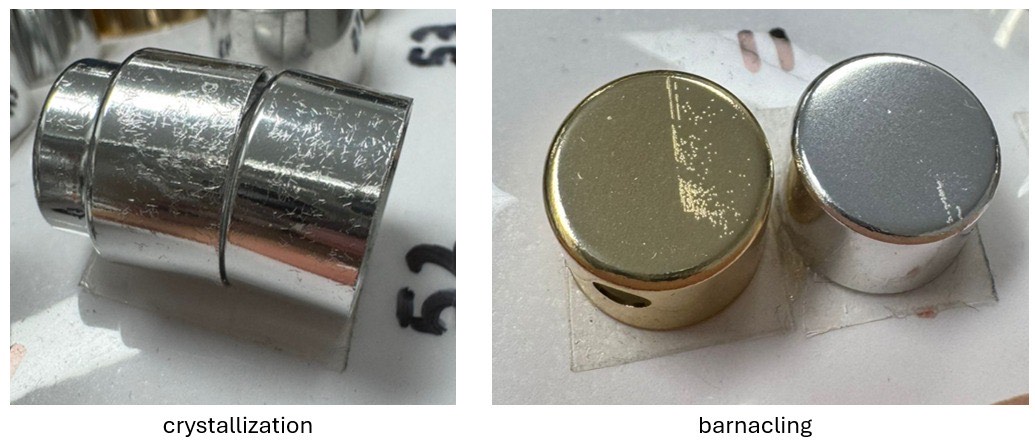
The defect I encountered this time I do not know the reason for. It did not seem that there was ice in the bath. We solved it by doing a partial renewal of the bath, but I would like to understand the cause.
At that moment, the bath parameters were: density 1.77 g/cm3, aluminum 35.22 g/L, nitric acid 5% (I could not measure the water content because my Karl Fischer was out of order), and we were operating at 100 °C. And I did not notice a reduction of air flow in the bath.
The polishing bath is never shut down; we run it 24/7. The defect appeared on all parts of the rack, mainly on the lower portion of the pieces.
Q. Do you still think this defect could have been generated by ice in the polishing bath?
- Spain
October 3, 2025
S
Thank you for your response. I can both feel and share your frustration as well as the feeling of being in the dark about what is happening and why. Your new additional pics are appreciated and in my humble opinion, they again seem to confirm the presence of ice. let's explore a little deeper again from the point of view of the supervisor because please recall i was neither a chemist nor a lab technician. I only saw the effects of the tank when it went out of spec and then made adjustments accordingly. ( i might add i did not always agree with the findings and recommendations of the lab because as you know, going " by the book" does not always work out. It might work in super controlled conditions like a laboratory or a test method, but not always in the shop.
Okay, returning now to the bright dip tank. From the shop point of view, this is what we find. When nitric is out of spec to the high side you will find an excessive amount of brown colored smoke during the bright dip process and then again when pulling the load from the tank. The fumes will be over-bearing as well both in odor and causing breathing to become difficult. You will even taste the nitric. You will also see pitting, but not what is being displayed in your pics. The pits will be shiny almost like jewelry. This is a signal that water is to the low side and you need to add water to the tank.
When you nitric is low, you will find the shine is not going to be there. This can be displayed also by the presence of dull pits. ( we know it is the nitric that performs the chemical polishing so there is not enough present to do its job.) hence you add nitric. This is like the phos is given a chance to do its thing and make the parts dull, loosely speaking like an etch, but more uniformly than as showed in your pics.
Water plays a key role as well. Too little and the nitric over-shines and starts to polish aggressively so you get shiny pits, sometimes if the pitting is dense enough it gives an orange peel effect, ( as when the solution settles on the surface due to poor agitation) looking like the skin of an orange. If the water content is too high, the nitric is hindered from doing its job and the phos steps in to lend a hand. You will have pitting but the pits will be dull, like an etched appearance. Tell-tale sign you need to add nitric..
I suppose the best way to say it is that over time, this back and forth with the water plays itself out and ice starts to form. When ice is present, it displays itself either by breaking loose and floating to the top...(most noticeable when the air agitation has been shut off,) or the second sign is the frosty appearance and pitting sometimes in a swirl pattern. (One of the pics you showed today with the pits that looked like slits or cuts in the surface could lend itself to being short on nitric. I believe that was the pic on the left. )
Pitting from the presence of ice is a completely different beast than pitting from out of spec chemistry. Again, it has a frosty appearance just like the pics you displayed in your initial post. Sometimes it may appear to look patchy while other times it could be random swirly line(s).
I would also like to say the agitation in your tank seems to be light years ahead of what alot of shops use. Simply having an air line is one thing but your company has gone over and above with the propeller agitation. While i myself have never seen it, i did hear about it. But, keep in mind, that is not going to inhibit the build-up of ice. The agitation only keeps solution from settling against the parts so the chemicals will polish properly.
Running your tank constantly without a break will boil away a lot of water. Generally the operating temp is 190-225 F. ( sorry i have no clue about metric.) you are hopefully adding water daily if not throughout the day. If your air is on for the duration that may be one reason you have not seen ice floating on the top because it stays in suspension. The size will vary from little crystals to ice cube to larger chunks.
Once again i can only share from my experience and the evidence on the parts in your first set of pics as well as the pic on the right ( if not mistaken) in the second set points to the presence of ice build-up in the tank. The pic on the left seemed to indicate a need for a nitric addition.
Here is one more suggestion. If you can safely access the tank and I mean safely, and presuming your tank is stainless steel, you can try to confirm the presence of ice on the bottom. If you find a long enough tool again like the scraper i told you about, you can walk around the tank and tap it against the bottom repeatedly as you walk You will hear and feel it both when it contacts the tank bottom but it will go strangely silent when it hits the ice. But again I emphasize ... with great care and taking all safety precautions. You NEVER want to climb atop any tank and especially the bright dip tank. Make sure the air is off as well because you do not want to stir up fumes and start ingesting them.
Retired - newport, tennessee usa
October 3, 2025
Q, A, or Comment on THIS thread -or- Start a NEW Thread